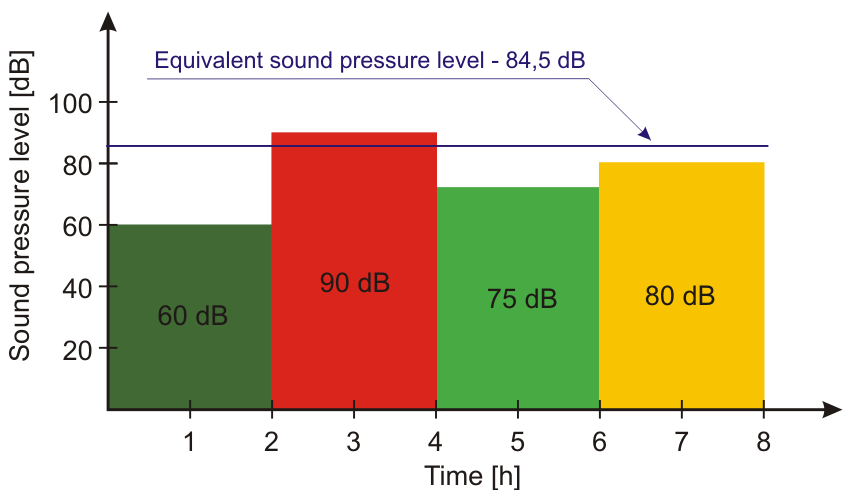Misją Instytutu jest dzialalność naukowo-badawcza prowadząca do nowych rozwiązań technicznych i organizacyjnych użytecznych w kształtowaniu warunków pracy zgodnych z zasadami bezpieczeństwa pracy i ergonomii oraz ustalanie podstaw naukowych do właściwego ukierunkowywania polityki społeczno-ekonomicznej państwa w tym zakresie.
(or in other words: in the spectrum of which there are sounds with such frequencies) - from 10 kHz
to 40 kHz. The frequencies given in the definition refer to the frequencies of the middle third octave bands (see further), which means that ultrasonic noise includes sounds with frequencies from
8.91 kHz to 44.88 kHz. The range of ultrasonic noise on the sound frequency scale is shown in Fig. 1.
Fig. 1. Ultrasonic noise on the frequency axis.
fg frequencies, which satisfy the following relationship:
In such a case, in order to determine the risk of ultrasonic noise for the worker during the shift,
the equivalent level of sound pressure should be used. Equivalent sound pressure level is the sound pressure level of a noise which, while operating for the same duration as noise with varying
sound pressure levels, carries the same acoustic energy and the same risk of hearing impairment.
Fig. 2 shows an example of changes in the sound pressure levels of ultrasonic noise during an 8-hour working day. The employee worked for the first two hours in a noise with a sound pressure level of 60 dB, the next two hours in a noise with a sound pressure level of 90 dB, then two hours in a noise with a sound pressure of 75 dB and two hours in a noise with a sound pressure level of 75 dB.
From an occupational exposure point of view, this corresponds to a situation where a worker would work eight hours in a noise with a sound pressure level of 84.5 dB.
Fig. 2. Changes in the sound pressure level as a function of time and the corresponding equivalent sound pressure level.
i-th third octave band is denoted by the symbol:

working time

8 h = 480 min = 28800 s.

The values characterizing the ultrasonic noise in the working environment and the values of the maximum allowable intensity (PEL) for these values (hereinafter referred to as the limit values) are specified in the annex to the Regulation of the Minister of Labour and Social Policy of June 12, 2018 on the maximum allowable concentrations and intensities of harmful factors for health in the work environment (Journal of Laws Dz.U. 2018, item 1286). According to this regulation, ultrasonic noise in the working environment is characterized by:
- equivalent levels of sound pressure in third octave bands with central frequencies from 10 to 40 kHz related to the 8-hour daily or the average weekly working time specified in the Labour Code (exceptionally in the case of the impact of ultrasonic noise on the human body in an uneven manner on individual days) in the week),
- maximum sound pressure levels in third octave bands with center frequencies
from 10 to 40 kHz.
The limit values specified for these values apply simultaneously and for all employees may not exceed the values given in Table 1.
|
The center frequency of one third octave band [kHz] |
Permissible equivalent sound pressure level related to the 8-hour daily (Lfeq,8h,dop) or to the average weekly (Lfeq,w,dop), defined in the Labour Code, working time [dB] |
Permissible maximum sound pressure level Lfmax [dB] |
|
10; 12,5; 16 |
80 |
100 |
|
20 |
90 |
110 |
|
25 |
105 |
125 |
|
31,5; 40; |
110 |
130 |
In the regulation of the Council of Ministers of August 24, 2004 on the list of works forbidden to young people and the conditions of employing them for some of these works (Journal of Laws Dz.U. of 2004, No. 200, item 2047, consolidated text of Journal of Laws Dz.U. of 2016, item 1509) are given ultrasonic noise limit values for young workers. Pursuant to this regulation, it is forbidden to employ adolescents in workplaces where the ultrasonic noise values exceed the permissible values specified in Table 2.
|
The center frequency of one third octave band [kHz] |
Permissible equivalent sound pressure level related to the 8-hour daily (Lfeq,8h,dop) or to the average weekly (Lfeq,w,dop), defined in the Labour Code, working time [dB] |
Permissible maximum sound pressure level Lfmax [dB] |
|
10; 12,5; 16 |
75 |
100 |
|
20 |
85 |
110 |
|
25 |
100 |
125 |
|
31,5; 40; |
105 |
130 |
|
The center frequency of one third octave band [kHz] |
Permissible equivalent sound pressure level related to the 8-hour daily (Lfeq,8h,dop) or to the average weekly (Lfeq,w,dop), defined in the Labour Code, working time [dB] |
Permissible maximum sound pressure level Lfmax [dB] |
|
10; 12,5; 16 |
75 |
95 |
|
20 |
85 |
105 |
|
25 |
100 |
120 |
|
31,5; 40; |
105 |
125 |
The assessment of the occupational risk related to exposure to ultrasonic noise consists primarily in the comparison of the measured or determined values (Lzm) of the quantities characterizing the ultrasonic noise at the workplace (equivalent sound pressure levels related to an 8-hour working day or working week and the maximum sound pressure levels - in frequency bands), to their permissible values (Ldop), valid at the same time. It should be taken into account whether the employee for whom the assessment is carried out belongs to the special risk group (adolescent or pregnant woman). When assessing occupational risk, one can adopt the principle described in the PN-N-18002 standard "Occupational health and safety management systems. General guidelines for occupational risk assessment", taking into account the multiplicity (k) of the limit value, which is the quotient of the measured value and the limit value (i.e. k = [ measured value] / [limit value]). According to the recommendations of the standard, based on the multiplication of the limit value, the occupational risk is assessed as:
|
k ≤ 0,5 |
low risk |
|
0,5 < k ≤ 1 |
medium risk |
|
k > 1,0 |
high risk |






